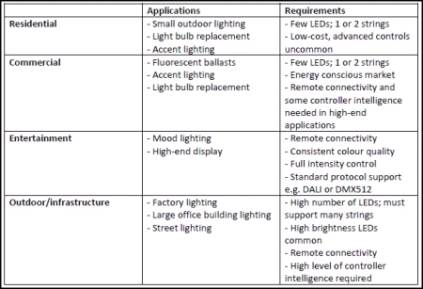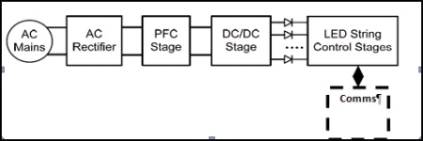In response to the global energy demands, lighting system engineers continue to develop alternative lighting methods, particularly light-emitting diode (LED) technology. LEDs can provide efficient, cost-effective and low environmental impact lighting solutions that can result in considerable energy savings, which is important in this era of ever-increasing electricity prices.
The different types of LED-based lighting applications and their requirements vary widely (Table 1). To enable the complex control functionality (e.g. specialized color mixing, balancing and dimming, adaptive lighting control, remote connectivity and self-diagnostics) and consistent light quality required for more advanced lighting applications, simple fixed-function LED drivers may become insufficient. Although fixed-function LED drivers have many advantageous qualities (low-cost, good power efficiency, no software programming, and ease of use) and are appropriate for many lighting systems, their capability for intelligent lighting systems is limited. Similarly, with relatively fixed function operation, more flexible solutions become advantageous when looking at design reuse across a product line. Significant cost reductions can be realized in design and purchasing when varying power and feature set requirements can be implemented without significant hardware modification.

Smart LED-based lighting systems require digital control using programmable microcontroller-based architectures that enable increased levels of intelligence and design flexibility, as well as efficient and cost-effective control of the luminaire power supply. Such architectures are able to support varying LED types and string lengths/numbers, and unique power stage requirements, generally with no major hardware changes. Most importantly, programmability also enables more advanced lighting control (sensing functions, remote connectivity, timing schedules, etc.), and likewise, this flexibility afforded by digital control means that a single controller can support a wider range of products to help lower overall system costs.
Smart LED-based lighting systems
By employing a flexible digital approach, it is possible for a single microcontroller, with sufficient performance, optimized power-control peripherals and robust communications ports, to provide a programmable platform that controls the three main stages of a smart LED-based lighting system; i.e. power conversion (precise/flexible control of AC rectification, power factor correction [PFC] and DC/DC conversion), LED control, and communications (Figure 1). This avoids the need for separate controllers for each stage as is necessary when using a fixed-function, analogue approach. This high level of integration reduces system complexity, and the component cost of a lighting unit power supply.

Figure 1: The main stages of a smart LED-based lighting system

Figure 2: Example of cost savings associated with efficiency gains in LED-based lighting solutions.





